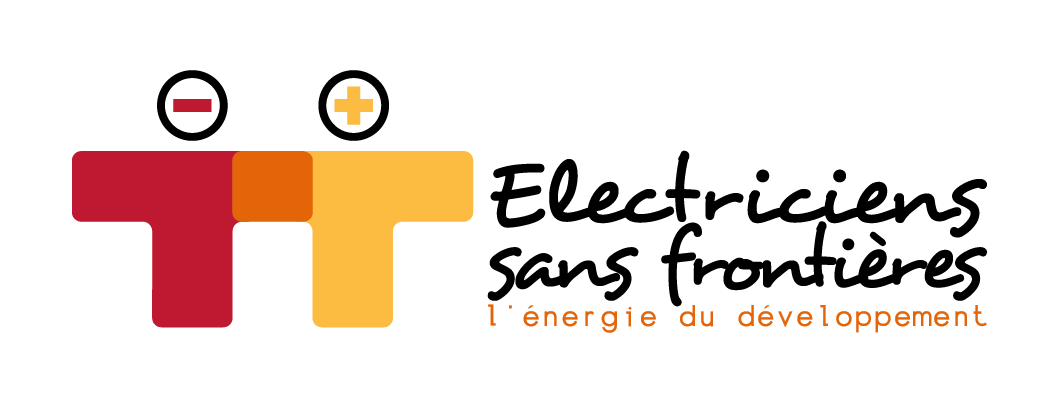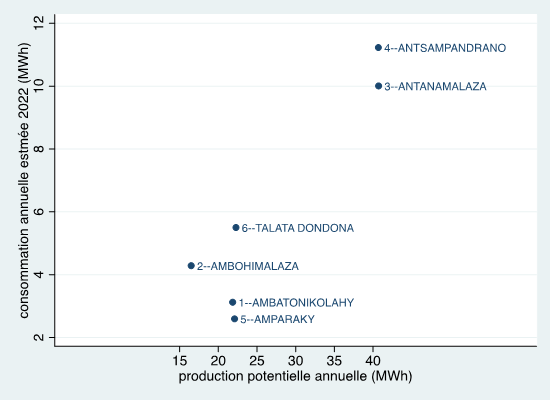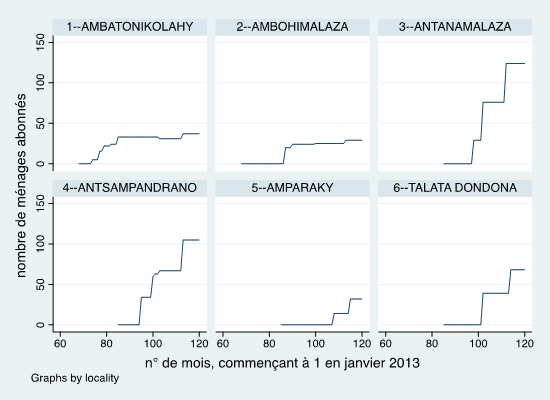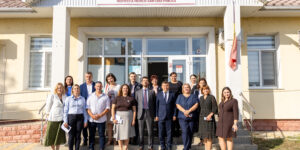Authors: Barès Serena and Berthelemy Jean-Claude
In four articles for Entreprenante Afrique, we present Electriciens sans frontières’ Cafés Lumière in Madagascar, and compare the results of different alternative evaluation methods carried out at affordable costs to test and assess the existence of positive impacts of the project on sustainable development objectives.
In this third section, we draw on the operator Anka’s activity reports, which provide, for each equipped locality, monthly series of electricity consumption by major types of use and associated data on the number of customers, which we supplement with the initial results of the socioeconomic survey conducted in 2017/18 and 2023, in its locality survey section. These data, which in part enable comparisons with control (non-equipped) localities, also make it possible to identify the main transmission channels for access to electricity in terms of sustainable development objectives. This analysis will be completed in the fourth issue of this blog by the processing of the household section of the survey, in which the responses from 50 households per locality will enable us to refine the diagnosis by considering the downstream effects of electrification on household well-being.
Overall power generation performance
We have already shown that the Cafés Lumière project has had a positive impact on access to electricity in the localities concerned. This impact can vary from one locality to another. An illustration of the impact of the Cafés Lumière on the provision of electricity by the mini-grid is provided by Figure 2, which compares total annual electricity consumption in 2022 with the production potential of the solar panels (converted into annual MWh).
Figure 1: Potential electricity generation and total electricity consumption by locality in 2022
Figure 1 shows that the higher the wattage, the greater the amount of electricity consumed, excluding street lighting. However, this relationship does not necessarily indicate a causal relationship, as the power of the installations has been established according to the population to be electrified. The relatively low ratios between daily consumption and potential generation correspond to the fact that the daily load curve is far from flat. In fact, in the 2023 locality survey, it is often reported that the mini-grid already exceeds its capacity during peak periods, which is a major constraint for the few three-phase subscribers.
The facilities at Ambatonikolahy and Amparaky seem to be producing below their potential, which may be due to a low number of household subscribers, with the largest consumers, as elsewhere, constrained by capacity. At Ambohimalaza, insufficient photovoltaic production during peak periods (husker use) is offset by the mobilization of the emergency diesel generator. A closer look at Anka’s activity reports will enable us to clarify these comments, just as it will provide an opportunity to compare the progress achieved in the main consumer categories.
Household consumption
ome households initially benefited from the Cafés Lumière business through the creation of boutiques. These stores, which operate like energy kiosks, have the merit of being aimed at people who can’t afford to pay a subscription to the mini-grid. Store receipts suggest that many households were initially customers of the store, then subscribed to the mini-network. Although the role of the boutiques was essential at the outset, the main quantitative effect of the project is now achieved through this channel.
Figure 2: Number of subscriber households
Figure 2 shows the evolution of the number of subscriber households. It is dynamic, but with a wide variety of situations. With the exception of the Cafés Lumière in Ambatonikolahy, Ambohimalaza and Amparaky, there has been fairly strong growth in household electricity use, but this growth is extensive rather than intensive (no noticeable dynamic in consumption per subscriber, of the order of 5kWh per month). To achieve real economic impact, we need to intensify the use of electricity by households, which would add income-generating consumption to domestic lighting. Additional information provided by Anka on the structure of electricity consumption in 2023 will enable us to observe the start of this dynamic in the next section.
Consumption of income-generating activities
The other main source of economic impact is, of course, the development of income-generating activities (IGAs) whose creation or modernization depends on the use of electricity. From this point of view, the results seem mixed. To date, there are very few IGAs mentioned in Anka’s activity reports: a maximum of 4 in Antanamalaza. In addition, most of these activities consume modest amounts of electricity, the only exceptions being hullers and grinders linked to agricultural activity in Ambatonikolahy, Ambohimalaza, Antsampandrano and Amparaky. Other activities include bars, carpentry, hairdressing, pastry-making, car painting, fishmongering and video games.
With a few exceptions, the development of IGAs is necessarily slow in coming, and additional data provided by Anka on the current situation at the beginning of 2023 indicates a real potential for evolution. Indeed, Anka has found that a number of households already use their subscription to run electrical appliances for productive activities, without having a subscription as contractors. By mid-2023, there would be 32 users of electricity generated by the mini-grid for service production purposes, including only 12 AGRs declared as such. The 20 producers counted in the households (representing 5% of total subscriber households) have a variety of activities, such as bars, grocery bars, gargotes, juice sales, telephone top-ups, multiservices and welding. These activities can be found in every locality, and their diversity is a testament to a certain dynamism. It should also be noted that the gargotes and boutiques identified in the locality section of our socio-economic survey, averaging 5 per locality, are only partially mentioned as service producers by Anka.
Consumption by service-producing households cannot be separated from total household consumption, but it can be approximated using data on consumption by IGAs declared as such. This estimated consumption is significantly higher, by around 40%, than that of other subscriber households. The development of these activities could subsequently increase the demand for electricity for productive uses, and therefore the economic impact of the Cafés Lumière.
Data from the locality section of the socio-economic survey allow a more precise interpretation of these consumption data. There was no significant increase in the number of service-producing activities, and no more so in the localities electrified by the mini-grid than in the control localities. On the other hand, whereas these activities previously operated, and still operate in the control localities, with diesel generators and individual solar panels, they have almost all converted to the electricity provided by the mini-grid in the equipped localities. This is a source of progress for the latter, as well as, for all the activities converted from diesel to solar mini-grids (on average more than 6 per locality), a source of contribution to environmental preservation.
Utilities
The final category of electricity consumption identified by Anka is utilities. It will represent a minority share of the electricity consumed on the mini-grid in 2022. Nevertheless, it can have a non-negligible impact on the achievement of sustainable development goals: health (SDG3), education (SDG4), peace, justice and effective institutions (SDG16).
The health objective is receiving a fair amount of attention, with all basic health centers (csb2) in localities electrified (5 csb2 in 6 localities supplied by the mini-grid, and an average monthly consumption of 23 kWh per csb2. By comparison, half were electrified (by solar panels) in 2017. All these health centers now benefit from lighting and refrigeration, but the use of electricity to operate medical equipment is still rare. The situation is very different in the control localities, where only half of the health centers will have access to electricity in 2023, generated by solar panels.
Education is also concerned, but with more limited ambitions. Starting from a situation where no schools were electrified in 2017, half of the schools in equipped localities are electrified but with low consumption (1.8 kWh per month per electrified school). By comparison, none of the other localities have electricity.
The collective activities associated with SDG16, 8 administrative structures and 10 churches, consume an average of 8 kWh per month per structure in electrified localities in 2022. In these localities, around half of the town halls and gendarmeries are electrified in areas equipped with a mini-grid. The churches are all electrified.
Street lighting can also have an impact on SDG16, in relation to safety. All the localities electrified by the Cafés Lumières have invested in street lighting, but not as a priority, as its connection to the mini-grid has sometimes been delayed. Its nocturnal amplitude is reduced outside Ambatonikolahy and Talata Dondona. In addition, the Amparaky mayor’s office abandoned the project in 2022 because the costs were deemed too high (this situation is subject to change in 2023). All in all, in 2022, electrified localities consumed just 12 kWh per month for public lighting, i.e. less than for administrative structures or churches.
Available street lighting is not significantly different in localities with mini-grids than in control localities, with an average of around 5 street lamps per locality. The mini-grid supplies 2/3 of the streetlights in the localities concerned. This does not seem to improve the security situation. The two localities with mini-grids providing extended night lighting reported no fewer safety problems. The main problems are associated with crop theft, and it seems that the main factor improving security is the activity of the gendarmerie.





